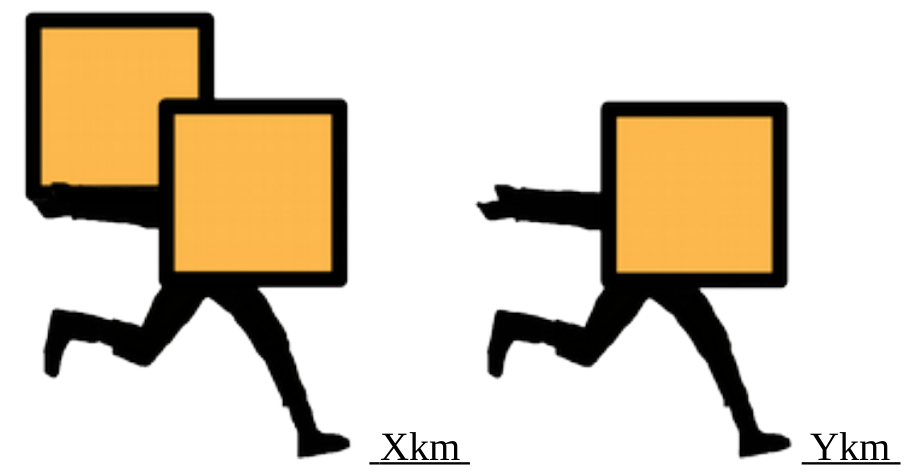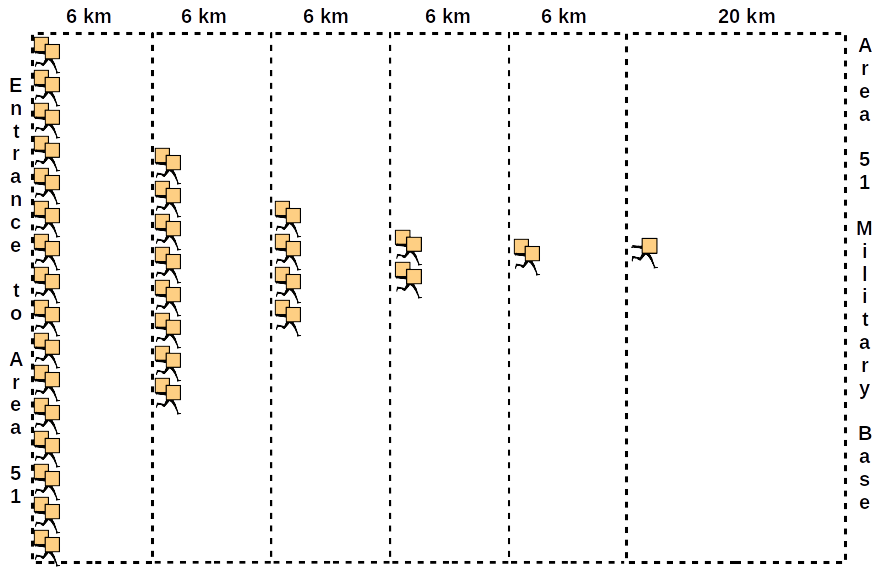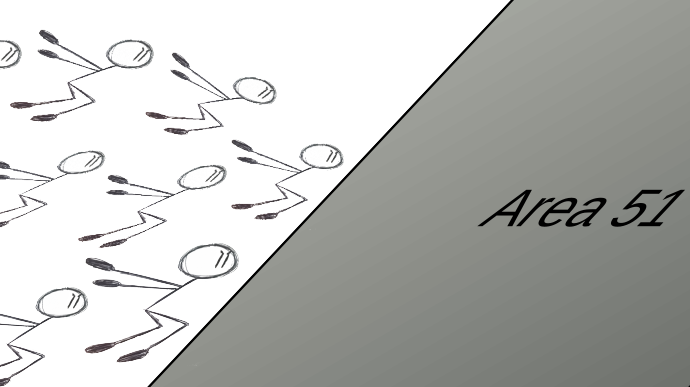Storm Area 51
It was scheduled for September 20, 2019 the Invasion of Area 51 running in the Naruto style, with more than 2 million confirmed. This incident raised concerns among the authorities and expectations about what could happen if confirmed people actually tried this. In this text we will discuss how the use of the logarithm could have made Invasion of Area 51 viable.
To place ourselves in this text, we must first keep in mind that:
1) Area 51 is a USA (secret) military base often associated with hiding various secrets from humanity, such as the discovery of intelligent extraterrestrial life. Its entrance until the arrival at the base of operations are about 50 km.
2) The Naruto running style (an anime with the main ninja theme) is based on the way the characters in this universe run, keeping their arms straight and stretched backwards while the body is bent forward.
So let us call Y the maximum distance that one of the P people in the invasion group can run continuously. We will call X the smallest of the maximum distances that the other P-1 people (we remove the person who runs Y from the set) can run carrying another person on their backs. Thus, ignoring the resistance and friction with the military authorities, would it be possible for the invasion group to run the 50km running in the Naruto style and thus conclude the Invasion of Area 51?
Case 1: Y≥50km. In this case, at least one person in the group can run alone to the base of Area 51.
Case 2: Y <50km. In that case, nobody in the group can run the 50 km without interruption. But the invasion in this case is still possible, since we can reduce the distance to be covered by Y by carrying each other on their backs.

Two people would travel (X+Y)km. In this case, the subject who runs Ykm (on the right) would be carried by the first Xkm (on the left).
In this situation we call P the total number of people and each portion of the rush rush. For a person to invade Area 51, we will need n-1 rushs carrying him on his back.
1st rush: P/2 people run X km carrying other P/2 people;
2nd rush: When they reach the X km, the P/2 people who were running until now stop running, and the P/4 of the loaded people start to load the other P/4 people who were being loaded;
3rd rush: When they reach the X km, the P/4 people who were running until now stop running, and the P/8 of the loaded people start to load the other P/8 people who were being loaded;
n-1st rush: When they reach the X km, the person who was running until now stops running, and the person who was being carried starts to run without carrying anyone.
In this way, a total of [(n-1).X + Y] km would be covered. In order to know the total number of rushs for this race, we need to calculate the logarithm on base 2 of the total number of people participating in the race. As we have an extra rush, referring to the guy who runs without carrying anyone, the expression we seek will be:
n ∈ ℕ, log2(P) < n ≤ 1+log2(P)
Example 1: 32 people gathered for the invasion. The one with the most resistance can run 20 km without interruption (Y=20), while the other 31 can run 6 km while carrying someone else on their back (X=6). In this way we will have log2 (32) rushs < n ≤ 1 + log2 (32) rushs = 6 rushs.

Race progression starting with 32 people, X = 6 and Y = 20.
1st rush: 16 people travel from 0 to 6 km carrying 16 people;
2nd rush: 8 people travel from 6 to 12 km carrying 8 people;
3rd rush: 4 people travel from 12 to 18 km carrying 4 people;
4th rush: 2 people travel from 18 to 24 km carrying 2 people;
5th rush: 1 person travel from 24 to 30 km carrying 1 person;
Final rush: 1 person travels 20 km.
Example 2: 1.024 people gathered for the invasion, (log2(1024) rushs < n ≤ 1 + log2(1024) rushs = 11 rushs) although we only increased 5 rushs, their representation on a sheet as in the previous example, if would make it difficult to view:
1st rush: 512 people travel from 0 to X km carrying 512 people;
2nd rush: 256 people travel from X to 2X km carrying 256 people;
3rd rush: 128 people travel from 2X to 3X km carrying 128 people;
4th rush: 64 people travel from 3X to 4X km carrying 64 people;
5th rush: 32 people travel from 4X to 5X km carrying 32 people;
6th rush: 16 people travel from 5X to 6X km carrying 16 people;
7th rush: 8 people travel from 6X to 7X km carrying 8 people;
8th rush: 4 people travel from 7X to 8X km carrying 4 people;
9th rush: 2 people travel from 8X to 9X km carrying 2 people;
10th rush: 1 person travels 9X to 10X km carrying 1 person;
Final rush: 1 person travels 50 km – 10X km.
So, if 50 – N.X – Y ≤ 0, the Invasion of Area 51 will be a success. We can describe each of these 3 variables (N; X; Y) as a function of the other two.
1. X ≥ (50-Y)/N | 2. N ≥ (50-Y)/X | 3. Y ≥ 50 – N.X |
For example, knowing that for the Invasion of Area 51 more than 2 million participants were confirmed (being pessimistic, let’s say we have exactly 2.000.001), log2(2.000.001) rushs < n ≤ 1 + log2 (2.000.001) rushs, that is, 20.9 < n <21.9 (notice how the number of people increases in relation to the rushs, first example we had 32 people and 6 rushs, in the second example 1.024 people and 11 rushs, here we have more than 2 million people and 21 rushs).
Assuming that of these, Y (maximum distance traveled by someone in the group) is 10 km. We have inequality 1.
X ≥ (50-10)/20
X ≥ 40/20
X ≥ 2.
That is, if X is greater than or equal to 2 km, the Invasion will be a success. This means, each person will need to run carrying his companion on his back for 2 km.
However, for inequalities:
4. X < (50-Y)/N
5. N < (50-Y)/X
6. Y < 50 – N.X
We cannot guarantee so easily that the Invasion would fail, as it would still be possible to rearrange the rush with different values of X1, X2, …, XN (distance that someone can run carrying another on their back) in order to maximize the total. Thus, the invasion will only fail if:
MAX {50 – N.(X1 + X2 + … + XN) – Y} > 0.

